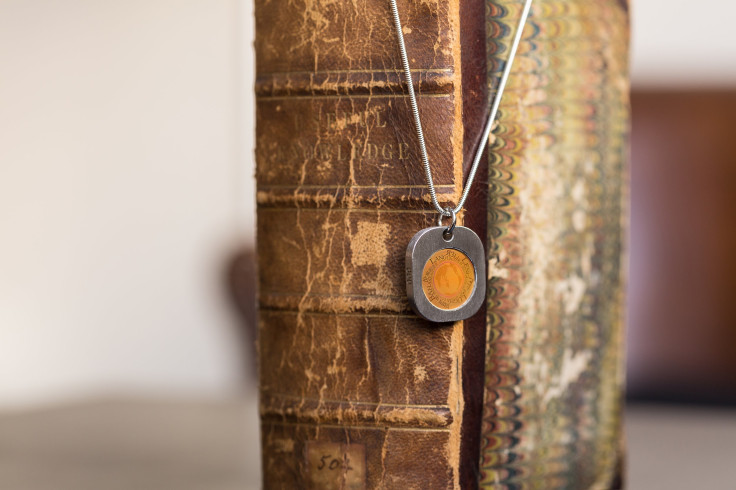Scientists Used Lasers To Make A Geektastic Necklace Archive Of 1,500 Languages

Wearable tech is getting an old school makeover with the Long Now Foundation’s Rosetta Project, a line of necklace pendants inscribed with lasers that hold nanoscale archives of around 1,500 languages. Unlike most high-tech jewelry, these necklaces don’t connect to an app or record biometrics. Instead, they are wearable libraries that can be read with a powerful microscope. The 2 centimeter-wide medallions are made with durable metals, so the necklaces are linguistic time capsules built to last several millennia.
New York wearables manufacturer Nano Rosetta only made 100 of these necklaces. Each costs $1,000, which counts as a donation to the Long Now Foundation’s cultural preservation projects. The wearable was inspired by the original Rosetta Stone, a piece of rock carved with ancient Egyptian hieroglyphs in 196 B.C. “The Rosetta Stone, when people were able to decipher that, it unlocked the writings of an ancient civilization,” project director Laura Welsher told International Business Times. “We’re trying to build up a library of human knowledge and preserve it for thousands of years.”
Read: Ringly Smart Jewelry Is Coming To Target
Welsher estimated there currently are 7,000 languages spoken across the globe although Science reported at least one language dies every two weeks. The Nano Rosetta pendant includes several endangered and indigenous languages, such as Māori from New Zealand and Elseng from Indonesia, alongside popular tongues like Arabic, Swahili and Hindi. “When we lose a language, it’s like losing a part of the encyclopedia of humanity,” Welsher said. “A lot of that information [knowledge from a specific culture] is encoded in the language.”
These necklaces are a geek dream come true. Not only do they include vocabulary lists, books and the United Nations declaration of human rights in diverse languages, they also include a diagram of the 10,000-year clock project funded by Amazon CEO Jeff Bezos. The clock is being built deep inside a mountain, hundreds of feet tall, to keep time and make music for 10,000 years. The archive’s content is almost as nerdy as the process that made it. Bruce Ha, president of the companies that designed and manufactured the wearable, used his own patented laser technology to inscribe the pendant.
“We used a highly focused laser beam that uses a lithographic process on a rotating platter,” he told IBT. In short, this technique is much faster and more compact than almost every other laser technology, so the pendant includes a massive amount of data on a surface the size of a small coin. “We have electronic copies [of modern language books], but they won’t last,” Ha said. “Just like the floppy disks, right? Just like the 8-track that was audio. Those things are gone and we can’t recover that data. That was only 40 to 50 years ago.”
So Ha made the pendants with nickel, one of the most durable metals on the planet, and designed a nanoscale archive readable even without modern computers. High-tech microscopes work best, but in a pinch, a drop of water, sunlight and some basic lenses would also reveal the intricate texts on the necklace. “You could still recover the information with some rudimentary tools,” he explained.
Motherboard reported the wearables are safe for people with nickel allergies because the engraved nickel slab is encased in stainless steel and covered with a watch crystal. This jewelry could serve as a bridge, across time, to future generations of curious scientists. “Hopefully, this will be like a secret decoder ring.” Welsher said.
Read: Which Is The World’s Most Spoken Language? Terpene. What’s That, You Ask?
© Copyright IBTimes 2025. All rights reserved.



















